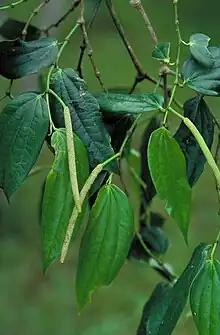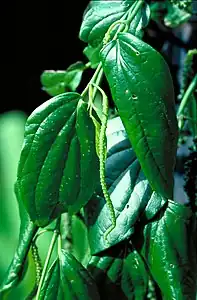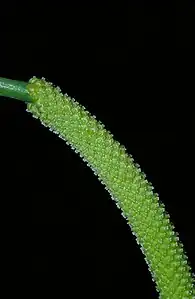Piper interruptum
Piper interruptum is a vine in the pepper family Piperaceae, native to the eastern parts of Southeast Asia and to Melanesia and Queensland.
| Piper interruptum | |
|---|---|
 | |
| Scientific classification | |
| Kingdom: | Plantae |
| Clade: | Tracheophytes |
| Clade: | Angiosperms |
| Clade: | Magnoliids |
| Order: | Piperales |
| Family: | Piperaceae |
| Genus: | Piper |
| Species: | P. interruptum |
| Binomial name | |
| Piper interruptum | |
| Synonyms[3] | |
Description
Piper interruptum is a root climber with a maximum stem diameter of 2 cm (0.79 in).[4] The leaves are ovate to narrowly ovate and mostly glabrous.[5] They measure up to 16 cm (6.3 in) long by 8.5 cm (3.3 in) wide, with a cuneate base which is often asymmetric, and an acuminate tip.[4][5] There are 1 to 3 pairs of lateral veins, all of which divert from the midvein in the basal portion of the leaf.[5] Petioles are 1 to 2 cm (0.39 to 0.79 in) long and stipules are 0.7 to 0.9 cm (0.28 to 0.35 in) long.[6]
This species is dioecious, meaning that functionally female and functionally male flowers are borne on separate plants.[5][6] The inflorescences are leaf-opposed pendulous spikes, around 0.4 cm (0.16 in) wide on a peduncle 1 to 2 cm (0.39 to 0.79 in) long − male spikes are 5 to 12 cm (2.0 to 4.7 in) long and female spikes are 7 to 19 cm (2.8 to 7.5 in) long.[5] The flowers are minute, just 0.5 mm (0.020 in) wide.[4]
Taxonomy
This species was first described by the Czech-German botanist Philipp Maximilian Opiz in 1828, his description was published in volume 1 of Carl Borivoj Presl's book Reliquiae Haenkeanae, seu, Descriptiones et icones plantarum.[7]: 157
Etymology
The species epithet is from the Latin interruptus, meaning "broken apart" or "interrupted".[6] Opiz wrote in his description spadicibus cylindricus laxis, interruptis − "spadix cylindrical, lax, interrupted" − but it is unclear what he meant by the term.
Distribution and habitat
The distribution of this species is from Taiwan south to the Philippines, New Guinea, the Bismarck Archipelago, the Solomon Islands, Vanuatu and Queensland.[3] In Queensland it occurs on the northeast coast from Cape Tribulation to Mackay.[6][8] It grows in rainforest at altitudes from near sea level to 800 m (2,600 ft), often on soils derived from basalt.[4][5][6]
Conservation
This species is listed by the Queensland Department of Environment and Science as least concern.[1] As of 9 March 2023, it has not been assessed by the IUCN.
Gallery
 Foliage and flowers
Foliage and flowers Female flowers
Female flowers Male flowers
Male flowers
References
- "Species profile—Piper interruptum". Queensland Department of Environment and Science. Queensland Government. 2022. Retrieved 9 March 2023.
- "Piper interruptum". Australian Plant Name Index (APNI). Centre for Plant Biodiversity Research, Australian Government. Retrieved 9 March 2023.
- "Piper interruptum Opiz". Plants of the World Online. Royal Botanic Gardens, Kew. Retrieved 9 March 2023.
- F.A.Zich; B.P.M.Hyland; T.Whiffen; R.A.Kerrigan (2020). "Piper interruptum". Australian Tropical Rainforest Plants Edition 8 (RFK8). Centre for Australian National Biodiversity Research (CANBR), Australian Government. Retrieved 9 March 2023.
- Spokes, T.M. (2021). Busby, John R. (ed.). "Piper interruptum". Flora of Australia. Australian Biological Resources Study, Department of Climate Change, the Environment and Water: Canberra. Retrieved 9 March 2023.
- Cooper, Wendy; Cooper, William T. (June 2004). Fruits of the Australian Tropical Rainforest. Clifton Hill, Victoria, Australia: Nokomis Editions. p. 398. ISBN 9780958174213.
- Presl, Carl Borivoj (1828). Reliquiae Haenkeanae, seu, Descriptiones et icones plantarum. Prague: J.G. Calve. Retrieved 10 March 2023.
- "Search: species: Piper interruptum | Occurrence records | The Australasian Virtual Herbarium". Australasian Virtual Herbarium. Australian Government. Retrieved 10 March 2023.
External links
 Data related to Piper interruptum at Wikispecies
Data related to Piper interruptum at Wikispecies Media related to Piper interruptum at Wikimedia Commons
Media related to Piper interruptum at Wikimedia Commons- View a map of historical sightings of this species at the Australasian Virtual Herbarium
- View observations of this species on iNaturalist
- View images of this species on Flickriver